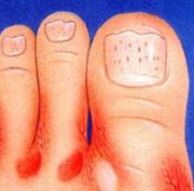According to statistics, every tenth resident of our planet suffers from the fungus of the legs, or, as it is called, epidermophytosis. Most often men suffer from this disease, which is more due to physiology features than the fact that men's representatives are more often and longer than women, wearing closed shoes.
Fungus on the legs: Causes and risk factors
The disease can be provoked by one of the following reasons:
- not sufficient body hygiene and especially legs;
- Uncomfortable and too tight shoes;
- Excessive sweating of the legs;
- violation of the work of the human immune system;
- deformation of flat legs and other types of legs;
- use of public pools and baths;
- insufficient bath hygiene and shower;
- Overweight;
- Problems related to the circulation of the legs.
General symptoms of foot fungus
The fungus on the legs can be manifested in different ways:
- dermatitis on the corner and pillow of the legs;
- itching of varying severity;
- cracks;
- peeling.
An accurate definition of the type of fungus, which impressed the leg, helps to choose the correct treatment of this disease.
Mushroom on the legs and its type
In medicine, the fungal type of fungus is 3 main types of membrane, such as mocasin, vesicularis. And they all have both general and characteristic symptoms.
Signs of membranard bomb:
- localization in the area of toes 4 and 5;
- Most types of mushroom types - scales;
- Itchy.
The fungus on the feet of the mocasin type differs from others:
- thickening of the feet;
- deeper cracks;
- painful feeling;

- Damage to the nails, which, like the legs, thickens but also obtains excessive fragility, which can even lead to loss of nail plate.
The vesicular fungus is characterized by: blisters filled with fluid and localization at the bottom of the foot.
Foot mushroom: diagnostics
The diagnosis of the "foot fungus" is made by a dermatologist based on the patient's examination. More detailed examinations: scrapes, skin biopsy, cultivation - help the doctor to accurately determine the type of fungus, which impressed the patient. Outside, the doctor does a sick survey to show this disease in the past. The latter is particularly important because the often repetitive manifestation of the fungus indicates the transition of the disease in a more severe form that is more difficult to treat.
How to handle a mushroom on your feet?
Foot fungus therapy does not require stationary observation and is performed on an outpatient basis. In most cases, the patient is prescribed external antifungal drugs. It is worth noting that people with foot fungus often do not turn to a specialist at all, limiting themselves to take medicines sold in a pharmacy without a prescription. This scenario often leads to a favorable result of the disease. However, it should be recalled that the long -term treatment of the disease, accompanied by deterioration of the leg of the legs, indicates the advanced stage of the disease. The best way for the situation is to visit a specialist to help you choose the optimal medicine of the fungus.



























